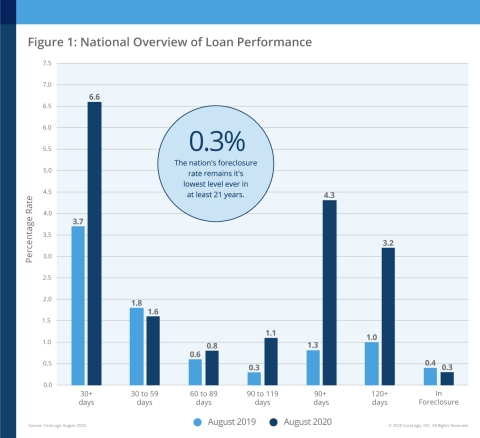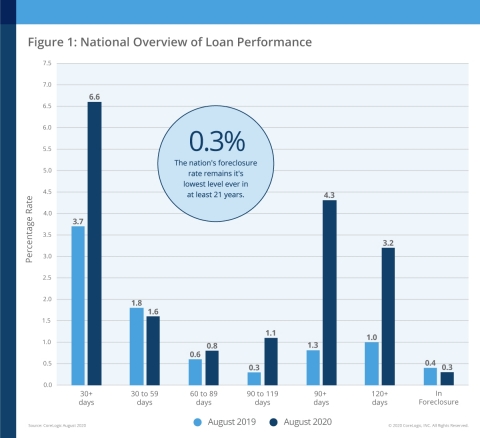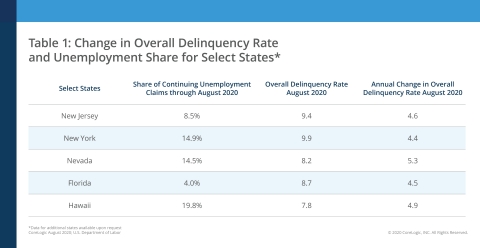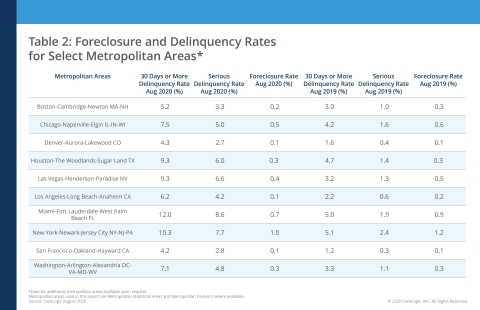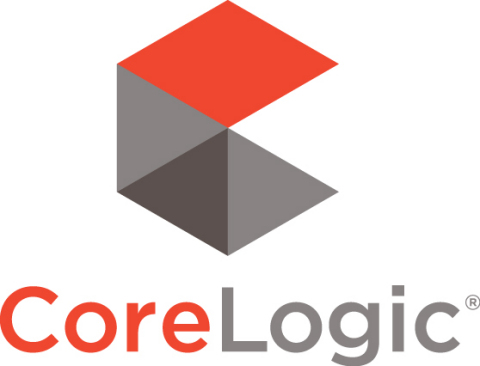IRVINE, Calif.--(BUSINESS WIRE)--CoreLogic® (NYSE: CLGX), a leading global property information, analytics and data-enabled solutions provider, today released its monthly Loan Performance Insights Report for August 2020. On a national level, 6.6% of mortgages were in some stage of delinquency (30 days or more past due, including those in foreclosure). This represents a 2.9-percentage point increase in the overall delinquency rate compared to August 2019, when it was 3.7%.
To gain an accurate view of the mortgage market and loan performance health, CoreLogic examines all stages of delinquency, including the share that transitions from current to 30 days past due. In August 2020, the U.S. delinquency and transition rates, and their year-over-year changes, were as follows:
- Early-Stage Delinquencies (30 to 59 days past due): 1.6%, down from 1.8% in August 2019, and down from 4.2% in April when early-stage delinquencies spiked.
- Adverse Delinquency (60 to 89 days past due): 0.8%, up from 0.6% in August 2019, but down from 1% in July and from 2.8% in May.
- Serious Delinquency (90 days or more past due, including loans in foreclosure): 4.3%, up from 1.3% in August 2019. This is the highest serious delinquency rate since February 2014.
- Foreclosure Inventory Rate (the share of mortgages in some stage of the foreclosure process): 0.3%, down from 0.4% in August 2019. The August 2020 foreclosure rate is the lowest since at least January 1999.
- Transition Rate (the share of mortgages that transitioned from current to 30 days past due): 0.9%, up from 0.8% in August 2019. The transition rate has slowed since April 2020, when it peaked at 3.4%.
Foreclosure rates remain low, in part due to forbearance programs and other government provisions. However, August 2020 marked a spike in 150-day past-due loans, reaching a historic high of 1.2%, likely due to large volumes of delinquencies moving in tandem through the pipeline. Homeowners nearing the end of the first 180-day grace period (afforded to borrowers with federally backed mortgages) can request an extension of an additional 180 days, which is keeping foreclosure rates low while serious delinquency continues to climb. However, back-mortgage payments continue to add up for those unable to exit forbearance periods early. Looming unpaid mortgage payments, paired with sharp declines in income for many families, point to a potential wave of home sales triggered by financial distress in 2021 as forbearance periods end.
“Forbearance programs continue to reduce the flow of homes into foreclosure and distressed sales and has been the key to helping many families who have been particularly hard hit by the pandemic," said Frank Martell, president and CEO of CoreLogic. "Even though foreclosure rates are at a historic low, the spike in 150-day past-due loans points to bumpy waters ahead.”
“Five months into the pandemic, the 150-day delinquency rate for August spiked to 1.2%,” said Dr. Frank Nothaft, chief economist at CoreLogic. “This was the highest rate in more than 21 years and double the January 2010 peak during the home-price bust. The spike in delinquency was all the more stunning given the generational low of 0.08% in March and April.”
In August, every state logged an annual increase in overall delinquency rates. Popular tourism destinations again showed the highest increases, with Nevada (up 5.3 percentage points), Hawaii (up 4.9 percentage points), New Jersey (up 4.6 percentage points), Florida (up 4.5 percentage points) and New York (up 4.4 percentage points) topping the list for gains.
Similarly, nearly all U.S. metro areas logged an increase in overall delinquency rates in August. Odessa, Texas — which has been hard hit by job loss in the oil and gas industry — again experienced the largest annual increase of 10.1 percentage points. Other metro areas with significant serious delinquency increases included Midland, Texas (up 7.9 percentage points); Kahului, Hawaii (up 7.6 percentage points) and Miami (up 7.0 percentage points). Dubuque, Iowa, was the only metro area to experience an annual decline in overall delinquency rate at -1.5%.
The next CoreLogic Loan Performance Insights Report will be released on December 8, 2020, featuring data for September 2020. For ongoing housing trends and data, visit the CoreLogic Insights Blog: www.corelogic.com/insights.
Methodology
The data in The CoreLogic LPI report represents foreclosure and delinquency activity reported through August 2020. The data in this report accounts for only first liens against a property and does not include secondary liens. The delinquency, transition and foreclosure rates are measured only against homes that have an outstanding mortgage. Homes without mortgage liens are not subject to foreclosure and are, therefore, excluded from the analysis. CoreLogic has approximately 75% coverage of U.S. foreclosure data.
Source: CoreLogic
The data provided is for use only by the primary recipient or the primary recipient's publication or broadcast. This data may not be re-sold, republished or licensed to any other source, including publications and sources owned by the primary recipient's parent company without prior written permission from CoreLogic. Any CoreLogic data used for publication or broadcast, in whole or in part, must be sourced as coming from CoreLogic, a data and analytics company. For use with broadcast or web content, the citation must directly accompany first reference of the data. If the data is illustrated with maps, charts, graphs or other visual elements, the CoreLogic logo must be included on screen or website. For questions, analysis or interpretation of the data, contact Valerie Sheets at newsmedia@corelogic.com. Data provided may not be modified without the prior written permission of CoreLogic. Do not use the data in any unlawful manner. This data is compiled from public records, contributory databases and proprietary analytics, and its accuracy is dependent upon these sources.
About CoreLogic
CoreLogic (NYSE: CLGX), the leading provider of property insights and solutions, promotes a healthy housing market and thriving communities. Through its enhanced property data solutions, services and technologies, CoreLogic enables real estate professionals, financial institutions, insurance carriers, government agencies and other housing market participants to help millions of people find, buy and protect their homes. For more information, please visit www.corelogic.com.
CORELOGIC and the CoreLogic logo are trademarks of CoreLogic, Inc. and/or its subsidiaries. All other trademarks are the property of their respective owners.

